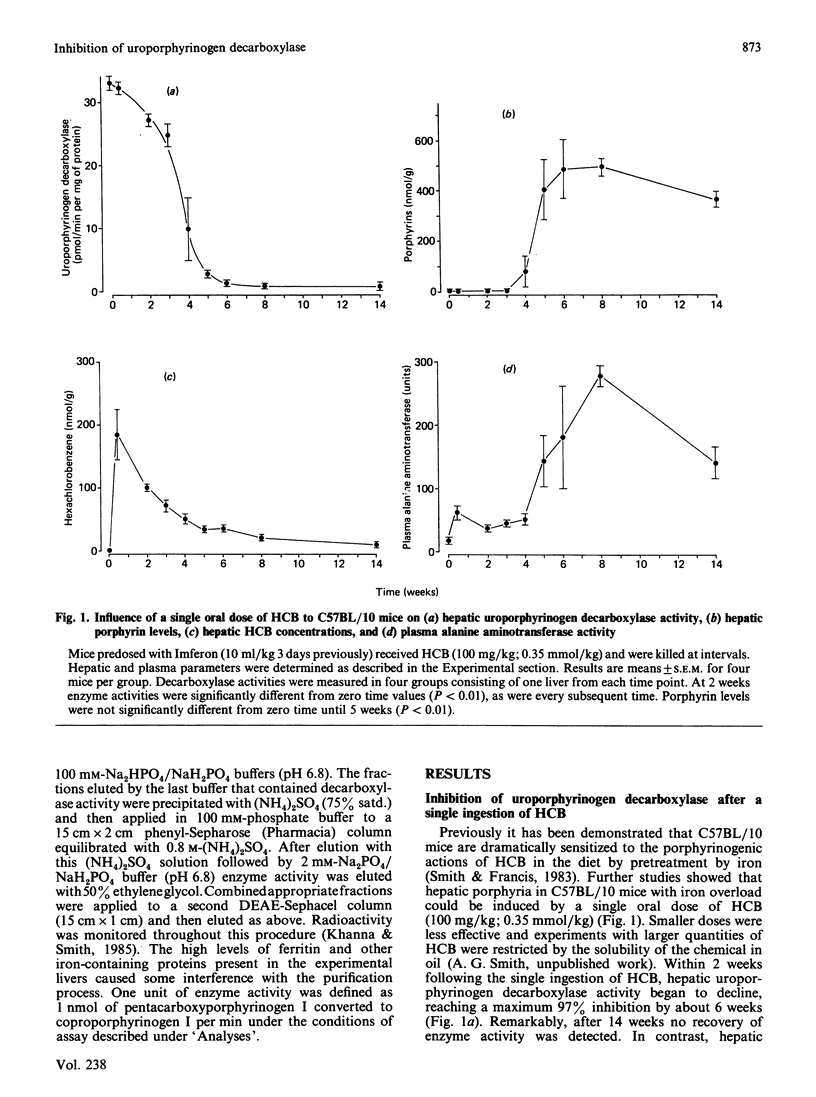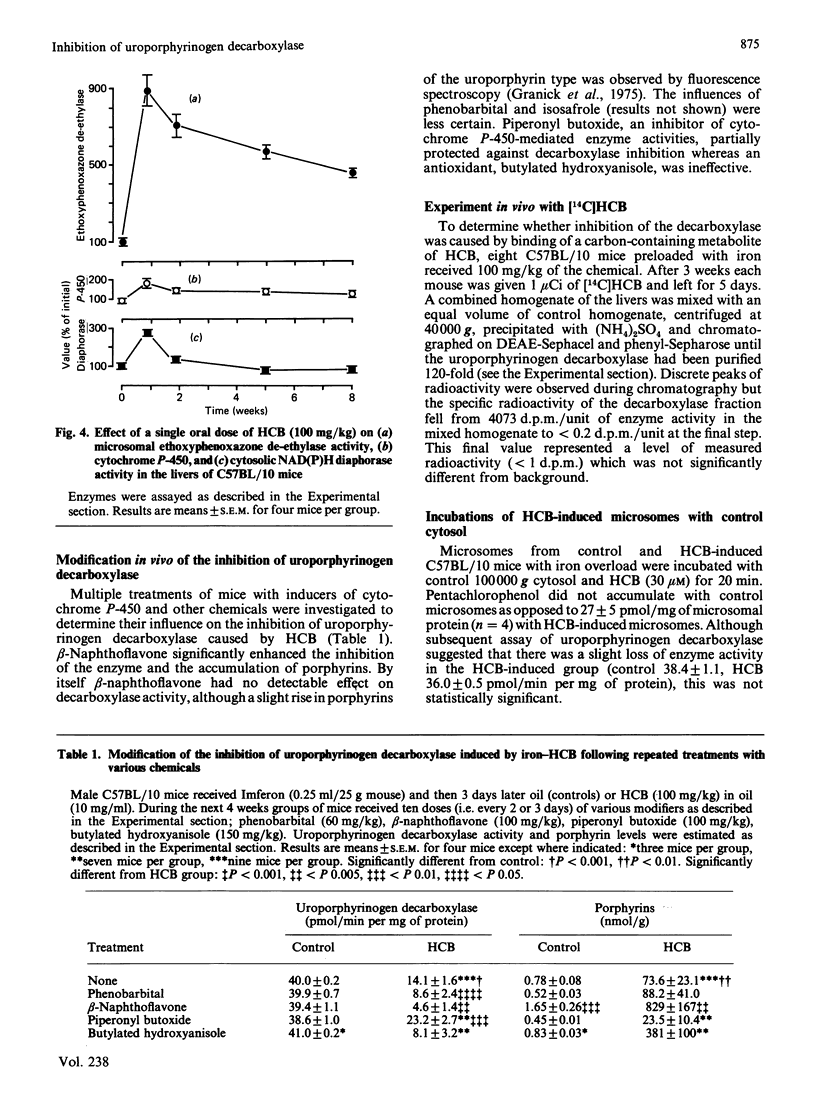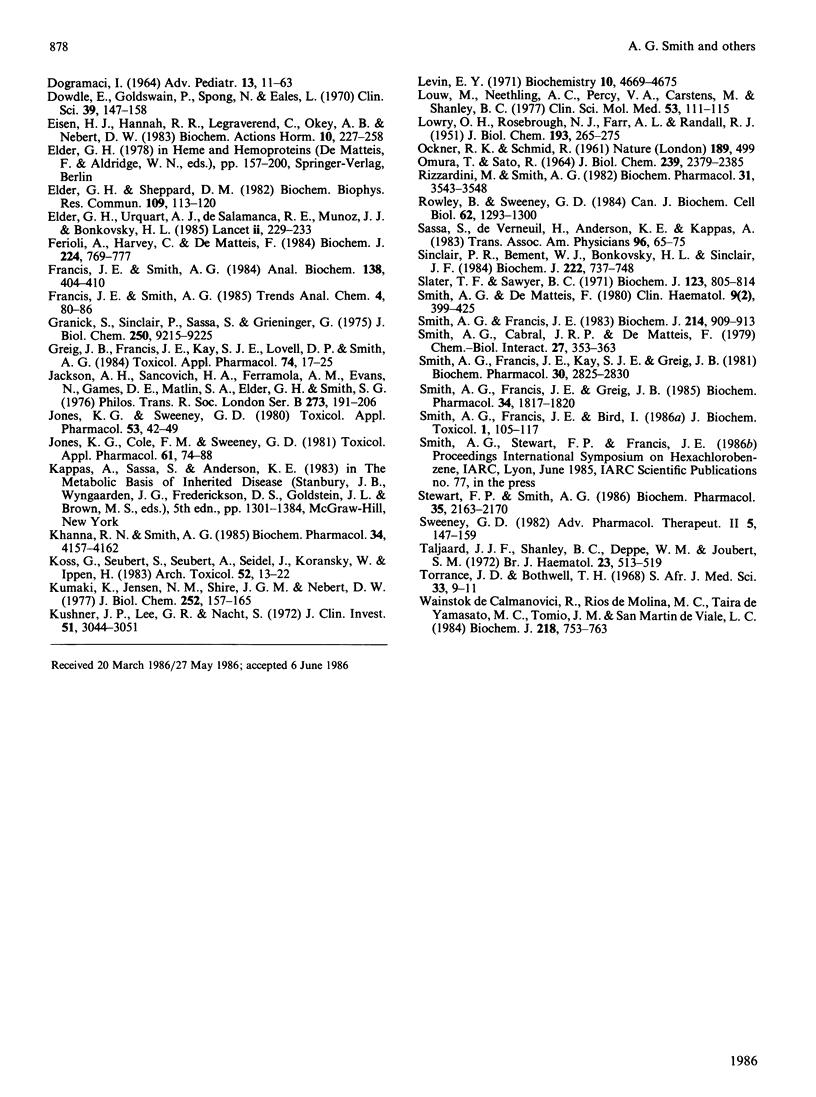Abstract
Porphyria was induced in C57BL/10 mice with iron overload by a single oral dose (100 mg/kg) of hexachlorobenzene (HCB). Within 2 weeks hepatic uroporphyrinogen decarboxylase (EC 4.1.1.37) was inhibited, reaching a maximum (greater than 95%) at 6-8 weeks. There was no recovery by 14 weeks, despite a fall in liver HCB concentrations to only 6% of the day-3 value. The major rise in hepatic porphyrin levels occurred after 4 weeks and secondary inhibition of uroporphyrinogen synthase (EC 4.2.1.75) was inferred from the progressively greater proportion of uroporphyrin I present relative to the III isomer. Plasma alanine aminotransferase (EC 2.6.1.2) activity was also elevated. Although, in further studies, total microsomal cytochrome P-450 content and ethoxyphenoxazone de-ethylase activity reached a peak a few days after dosing and had declined significantly at the time of maximum inhibition of the decarboxylase, additional treatment of HCB-dosed mice with a cytochrome P1-450 inducer, beta-naphthoflavone, enhanced the inhibition, whereas piperonyl butoxide, an inhibitor of cytochrome P-450, partially protected. Uroporphyrinogen decarboxylase was not radiolabelled in vivo by [14C]HCB. There was no major difference in the ability to hydroxylate HCB between hepatic microsomes from induced C57BL/10 mice and those from the insensitive DBA/2 strain. By contrast, lipid peroxidation, in the presence of NADPH, was 8-fold greater in control C57BL/10 microsomes than in DBA/2 microsomes and was stimulated by iron treatment (although not by HCB). The results suggest that the inhibition of hepatic uroporphyrinogen decarboxylase is unlikely to be due to a direct effect of a metabolite of HCB but to another process requiring a specific cytochrome P-450 isoenzyme and an unknown iron species.
Full text
PDF







Selected References
These references are in PubMed. This may not be the complete list of references from this article.
- Burke M. D., Mayer R. T. Differential effects of phenobarbitone and 3-methylcholanthrene induction on the hepatic microsomal metabolism and cytochrome P-450-binding of phenoxazone and a homologous series of its n-alkyl ethers (alkoxyresorufins). Chem Biol Interact. 1983 Jul 15;45(2):243–258. doi: 10.1016/0009-2797(83)90072-8. [DOI] [PubMed] [Google Scholar]
- Cantoni L., dal Fiume D., Rizzardini M., Ruggieri R. In vitro inhibitory effect on porphyrinogen carboxylyase of liver extracts from TCDD treated mice. Toxicol Lett. 1984 Feb;20(2):211–217. doi: 10.1016/0378-4274(84)90149-8. [DOI] [PubMed] [Google Scholar]
- Carpenter H. M., Williams D. E., Henderson M. C., Bender R. C., Buhler D. R. Hexachlorobenzene-induced porphyria in Japanese quail. Effect of pretreatment with phenobarbital or beta-naphthoflavone. Biochem Pharmacol. 1984 Dec 1;33(23):3875–3881. doi: 10.1016/0006-2952(84)90054-6. [DOI] [PubMed] [Google Scholar]
- Cheeseman K. H., Proudfoot K. A., Maddix S. P., Collins M. M., Milia A., Slater T. F. Low rate of NADPH/ADP-iron dependent lipid peroxidation in hepatic microsomes of DBA/2 mice. FEBS Lett. 1985 May 20;184(2):343–346. doi: 10.1016/0014-5793(85)80635-9. [DOI] [PubMed] [Google Scholar]
- DE MATTEIS F., PRIOR B. E., RIMINGTON C. Nervous and biochemical disturbances following hexachlorobenzene intoxication. Nature. 1961 Jul 22;191:363–366. doi: 10.1038/191363a0. [DOI] [PubMed] [Google Scholar]
- DOGRAMACI I. PORPHYRIAS AND PORPHYRIN METABOLISM, WITH SPECIAL REFERENCE TO PORPHYRIA IN CHILDHOOD. Adv Pediatr. 1964;13:11–63. [PubMed] [Google Scholar]
- De Matteis F., Stonard M. Experimental porphyrias as models for human hepatic porphyrias. Semin Hematol. 1977 Apr;14(2):187–192. [PubMed] [Google Scholar]
- Debets F., Reinders J. H., Koss G., Seidel J., Strik A. Effects of dietary antioxidants on the biotransformation and porphyrinogenic action of hexachlorobenzene in two strains of rats. Chem Biol Interact. 1981 Oct;37(1-2):77–94. doi: 10.1016/0009-2797(81)90167-8. [DOI] [PubMed] [Google Scholar]
- Dowdle E., Goldswain P., Spong N., Eales L. The pattern of porphyrin isomer accumulation and excretion in symptomatic porphyria. Clin Sci. 1970 Aug;39(2):147–158. doi: 10.1042/cs0390147. [DOI] [PubMed] [Google Scholar]
- Elder G. H., Sheppard D. M. Immunoreactive uroporphyrinogen decarboxylase is unchanged in porphyria caused by TCDD and hexachlorobenzene. Biochem Biophys Res Commun. 1982 Nov 16;109(1):113–120. doi: 10.1016/0006-291x(82)91573-x. [DOI] [PubMed] [Google Scholar]
- Elder G. H., Urquhart A. J., De Salamanca R. E., Munoz J. J., Bonkovsky H. L. Immunoreactive uroporphyrinogen decarboxylase in the liver in porphyria cutanea tarda. Lancet. 1985 Aug 3;2(8449):229–233. doi: 10.1016/s0140-6736(85)90287-9. [DOI] [PubMed] [Google Scholar]
- Ferioli A., Harvey C., De Matteis F. Drug-induced accumulation of uroporphyrin in chicken hepatocyte cultures. Structural requirements for the effect and role of exogenous iron. Biochem J. 1984 Dec 15;224(3):769–777. doi: 10.1042/bj2240769. [DOI] [PMC free article] [PubMed] [Google Scholar]
- Francis J. E., Smith A. G. Assay of mouse liver uroporphyrinogen decarboxylase by reverse-phase high-performance liquid chromatography. Anal Biochem. 1984 May 1;138(2):404–410. doi: 10.1016/0003-2697(84)90829-7. [DOI] [PubMed] [Google Scholar]
- Granick S., Sinclair P., Sassa S., Grieninger G. Effects by heme, insulin, and serum albumin on heme and protein synthesis in chick embryo liver cells cultured in a chemically defined medium, and a spectrofluorometric assay for porphyrin composition. J Biol Chem. 1975 Dec 25;250(24):9215–9225. [PubMed] [Google Scholar]
- Greig J. B., Francis J. E., Kay S. J., Lovell D. P., Smith A. G. Incomplete correlation of 2,3,7,8-tetrachlorodibenzo-p-dioxin hepatotoxicity with Ah phenotype in mice. Toxicol Appl Pharmacol. 1984 Jun 15;74(1):17–25. doi: 10.1016/0041-008x(84)90265-5. [DOI] [PubMed] [Google Scholar]
- Jackson A. H., Sancovich H. A., Ferramola A. M., Evans N., Games D. E., Matlin S. A., Elder G. H., Smith S. G. Macrocyclic intermediates in the biosynthesis of porphyrins. Philos Trans R Soc Lond B Biol Sci. 1976 Feb 5;273(924):191–206. doi: 10.1098/rstb.1976.0009. [DOI] [PubMed] [Google Scholar]
- Jones K. G., Cole F. M., Sweeney G. D. The role of iron in the toxicity of 2,3,7,8-tetrachlorodibenzo-(p)-dioxin (TCDD). Toxicol Appl Pharmacol. 1981 Oct;61(1):74–88. doi: 10.1016/0041-008x(81)90009-0. [DOI] [PubMed] [Google Scholar]
- Jones K. G., Sweeney G. D. Dependence of the porphyrogenic effect of 2,3,7,8-tetrachlorodibenzo(p)dioxin upon inheritance of aryl hydrocarbon hydroxylase responsiveness. Toxicol Appl Pharmacol. 1980 Mar 30;53(1):42–49. doi: 10.1016/0041-008x(80)90379-8. [DOI] [PubMed] [Google Scholar]
- Khanna R. N., Smith A. G. Fate of hexachlorobenzene in C57BL/10 mice with iron overload. Biochem Pharmacol. 1985 Dec 1;34(23):4157–4162. doi: 10.1016/0006-2952(85)90209-6. [DOI] [PubMed] [Google Scholar]
- Koss G., Seubert S., Seubert A., Seidel J., Koransky W., Ippen H. Studies on the toxicology of hexachlorobenzene. V. Different phases of porphyria during and after treatment. Arch Toxicol. 1983 Jan;52(1):13–22. doi: 10.1007/BF00317978. [DOI] [PubMed] [Google Scholar]
- Kumaki K., Jensen N. M., Shire J. G., Nebert D. W. Genetic differences in induction of cytosol reduced-NAD(P):menadione oxidoreductase and microsomal aryl hydrocarbon hydroxylase in the mouse. J Biol Chem. 1977 Jan 10;252(1):157–165. [PubMed] [Google Scholar]
- Kushner J. P., Lee G. R., Nacht S. The role of iron in the pathogenesis of porphyria cutanea tarda. An in vitro model. J Clin Invest. 1972 Dec;51(12):3044–3051. doi: 10.1172/JCI107131. [DOI] [PMC free article] [PubMed] [Google Scholar]
- LOWRY O. H., ROSEBROUGH N. J., FARR A. L., RANDALL R. J. Protein measurement with the Folin phenol reagent. J Biol Chem. 1951 Nov;193(1):265–275. [PubMed] [Google Scholar]
- Levin E. Y. Enzymatic properties of uroporphyrinogen 3 cosynthetase. Biochemistry. 1971 Dec 7;10(25):4669–4675. doi: 10.1021/bi00801a012. [DOI] [PubMed] [Google Scholar]
- Louw M., Neethling A. C., Percy V. A., Carstens M., Shanley B. C. Effects of hexachlorobenzene feeding and iron overload on enzymes of haem biosynthesis and cytochrome P 450 in rat liver. Clin Sci Mol Med. 1977 Aug;53(2):111–115. doi: 10.1042/cs0530111. [DOI] [PubMed] [Google Scholar]
- OCKNER R. K., SCHMID R. Acquired porphyria in man and rat due to hexachlorobenzene intoxication. Nature. 1961 Feb 11;189:499–499. doi: 10.1038/189499a0. [DOI] [PubMed] [Google Scholar]
- OMURA T., SATO R. THE CARBON MONOXIDE-BINDING PIGMENT OF LIVER MICROSOMES. II. SOLUBILIZATION, PURIFICATION, AND PROPERTIES. J Biol Chem. 1964 Jul;239:2379–2385. [PubMed] [Google Scholar]
- Rizzardini M., Smith A. G. Sex differences in the metabolism of hexachlorobenzene by rats and the development of porphyria in females. Biochem Pharmacol. 1982 Nov 15;31(22):3543–3548. doi: 10.1016/0006-2952(82)90573-1. [DOI] [PubMed] [Google Scholar]
- Rowley B., Sweeney G. D. Release of ferrous iron from ferritin by liver microsomes: a possible role in the toxicity of 2,3,7,8-tetrachlorodibenzo-p-dioxin. Can J Biochem Cell Biol. 1984 Dec;62(12):1293–1300. doi: 10.1139/o84-165. [DOI] [PubMed] [Google Scholar]
- Sassa S., de Verneuil H., Anderson K. E., Kappas A. Purification and properties of human erythrocyte uroporphyrinogen decarboxylase: immunological demonstration of the enzyme defect in porphyria cutanea tarda. Trans Assoc Am Physicians. 1983;96:65–75. [PubMed] [Google Scholar]
- Sinclair P. R., Bement W. J., Bonkovsky H. L., Sinclair J. F. Inhibition of uroporphyrinogen decarboxylase by halogenated biphenyls in chick hepatocyte cultures. Essential role for induction of cytochrome P-448. Biochem J. 1984 Sep 15;222(3):737–748. doi: 10.1042/bj2220737. [DOI] [PMC free article] [PubMed] [Google Scholar]
- Slater T. F., Sawyer B. C. The stimulatory effects of carbon tetrachloride and other halogenoalkanes on peroxidative reactions in rat liver fractions in vitro. General features of the systems used. Biochem J. 1971 Aug;123(5):805–814. doi: 10.1042/bj1230805. [DOI] [PMC free article] [PubMed] [Google Scholar]
- Smith A. G., Cabral J. R., De Matteis F. A difference between two strains of rats in their liver non-haem iron content and in their response to the porphyrogenic effect of hexachlorobenzene. Chem Biol Interact. 1979 Oct;27(2-3):353–363. doi: 10.1016/0009-2797(79)90138-8. [DOI] [PubMed] [Google Scholar]
- Smith A. G., De Matteis F. Drugs and the hepatic porphyrias. Clin Haematol. 1980 Jun;9(2):399–425. [PubMed] [Google Scholar]
- Smith A. G., Francis J. E., Bird I. Distinction between octachlorostyrene and hexachlorobenzene in their potentials to induce ethoxyphenoxazone deethylase and cause porphyria in rats and mice. J Biochem Toxicol. 1986 Mar;1(1):105–117. doi: 10.1002/jbt.2570010111. [DOI] [PubMed] [Google Scholar]
- Smith A. G., Francis J. E., Greig J. B. Continued depression of hepatic uroporphyrinogen decarboxylase activity caused by hexachlorobenzene or 2,3,7,8-tetrachlorodibenzo-p-dioxin despite regeneration after partial hepatectomy. Biochem Pharmacol. 1985 May 15;34(10):1817–1820. doi: 10.1016/0006-2952(85)90654-9. [DOI] [PubMed] [Google Scholar]
- Smith A. G., Francis J. E., Kay S. J., Greig J. B. Hepatic toxicity and uroporphyrinogen decarboxylase activity following a single dose of 2,3,7,8-tetrachlorodibenzo-p-dioxin to mice. Biochem Pharmacol. 1981 Oct;30(20):2825–2830. doi: 10.1016/0006-2952(81)90421-4. [DOI] [PubMed] [Google Scholar]
- Smith A. G., Francis J. E. Synergism of iron and hexachlorobenzene inhibits hepatic uroporphyrinogen decarboxylase in inbred mice. Biochem J. 1983 Sep 15;214(3):909–913. doi: 10.1042/bj2140909. [DOI] [PMC free article] [PubMed] [Google Scholar]
- Stewart F. P., Smith A. G. Metabolism of the "mixed" cytochrome P-450 inducer hexachlorobenzene by rat liver microsomes. Biochem Pharmacol. 1986 Jul 1;35(13):2163–2170. doi: 10.1016/0006-2952(86)90587-3. [DOI] [PubMed] [Google Scholar]
- Taljaard J. J., Shanley B. C., Deppe W. M., Joubert S. M. Prophyrin metabolism in experimental hepatic siderosis in the rat. II. Combined effect of iron overload and hexachlorobenzene. Br J Haematol. 1972 Oct;23(4):513–519. doi: 10.1111/j.1365-2141.1972.tb07086.x. [DOI] [PubMed] [Google Scholar]
- Torrance J. D., Bothwell T. H. A simple technique for measuring storage iron concentrations in formalinised liver samples. S Afr J Med Sci. 1968 Apr;33(1):9–11. [PubMed] [Google Scholar]
- Wainstok de Calmanovici R., Ríos de Molina M. C., Taira de Yamasato M. C., Tomio J. M., San Martin de Viale L. C. Mechanism of hexachlorobenzene-induced porphyria in rats. Effect of phenobarbitone pretreatment. Biochem J. 1984 Mar 15;218(3):753–763. doi: 10.1042/bj2180753. [DOI] [PMC free article] [PubMed] [Google Scholar]
- de Verneuil H., Beaumont C., Deybach J. C., Nordmann Y., Sfar Z., Kastally R. Enzymatic and immunological studies of uroporphyrinogen decarboxylase in familial porphyria cutanea tarda and hepatoerythropoietic porphyria. Am J Hum Genet. 1984 May;36(3):613–622. [PMC free article] [PubMed] [Google Scholar]


